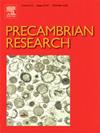Precambrian tectonic evolution of the Songliao–Xilinhot block in the context of a supercontinent cycle: Evidence from Neoarchean granitoid rocks in the Longjiang area, NE China
IF 3.2
2区 地球科学
Q2 GEOSCIENCES, MULTIDISCIPLINARY
引用次数: 0
Abstract
The Songliao–Xilinhot block (SXB) in the eastern part of the Central Asian Orogenic Belt (CAOB) is a Precambrian continental block that provides clues to the evolution of the CAOB. However, its structural relationship with adjoining terranes and cratons, and its role in past supercontinent cycles remain unclear. Here, we describe the whole-rock geochemistry, zircon U–Pb ages, and Sr–Nd–Hf isotopic data of Neoarchean granitoid rocks in the Longjiang area of the SXB, NE China. Zircon U–Pb dating indicates that tonalite–trondhjemite–granodiorites (TTGs) and monzogranites were formed at 2.56–2.55 and 2.55–2.51 Ga, respectively. The TTGs have low MgO, Y, and Yb, and high Sr contents. Their Sr/Y and (La/Yb)N ratios and YbN values vary widely, with εHf(t) values of –2.8 to + 3.1 and a εNd(t) value of + 2.4. Thus, the TTGs are medium- and low-pressure types, possibly formed by partial melting of middle Archean basic lower crust. The monzonitic granites have high K2O contents, high K2O/Na2O, Sr/Y, and (La/Yb)N ratios, low MgO contents and Mg# values, and variable εHf(t) and εNd(t) values (–3.1 to + 6.3 and –0.9 to + 2.8). The geochemical characteristics and Hf–Nd isotopic compositions of then monzogranites indicate that their parental magmas were formed by partial melting of thickened lower crust derived from heterogeneous sources. Thickening of the lower crust during the late Neoarchean may have promoted the formation of the TTGs and monzogranites. U–Pb and Lu–Hf isotopic data for magmatic zircons from Precambrian intrusive rocks, and detrital zircons from Meso-Neoproterozoic metasedimentary rocks in the SXB were studied to elucidate the origin of the Precambrian SXB. Results indicate a close affinity of the SXB with Laurentia in the Precambrican, while geological evidence and the presence of 1.4 Ga A-type granite in the SXB preclude most cratons as being the source of the Precambrian SXB. Precambrian magmatic events, sedimentary sequences, and significant changes in zircon Hf isotopic compositions within the Precambrian SXB indicate that the block responded to the assembly of the Nuna supercontinents. It underwent a change in tectonic environment from long-term subduction and extension to short-term collision during the breakup of Nuna and subsequent amalgamation with Rodinia.
超大陆旋回背景下松辽—锡林浩特地块前寒武纪构造演化:来自龙江地区新太古代花岗岩类岩石的证据
松辽—锡林浩特地块位于中亚造山带东部,是一个前寒武纪大陆地块,为中亚造山带的演化提供了线索。然而,其与相邻地体和克拉通的构造关系及其在过去超大陆旋回中的作用尚不清楚。本文描述了陇江地区新太古代花岗岩类岩石的全岩地球化学、锆石U-Pb年龄和Sr-Nd-Hf同位素数据。锆石U-Pb测年表明,该区的闪长闪长岩(TTGs)和二长花岗岩分别形成于2.56 ~ 2.55 Ga和2.55 ~ 2.51 Ga。ttg的MgO、Y、Yb含量低,Sr含量高。它们的Sr/Y和(La/Yb)N比值及YbN值变化很大,εHf(t)值为-2.8 ~ + 3.1,εNd(t)值为+ 2.4。因此,ttg为中、低压型,可能是中太古宙基性下地壳部分熔融形成的。二长花岗岩K2O含量高,K2O/Na2O、Sr/Y和(La/Yb)N比值高,MgO含量和Mg#值低,εHf(t)和εNd(t)值变化较大(-3.1 ~ + 6.3和-0.9 ~ + 2.8)。二长花岗岩的地球化学特征和Hf-Nd同位素组成表明,它们的母岩浆是由非均质源的增厚下地壳部分熔融形成的。新太古代晚期下地壳的增厚可能促进了ttg和二长花岗岩的形成。研究了前寒武纪侵入岩岩浆锆石和中-新元古代变质沉积岩碎屑锆石的U-Pb、Lu-Hf同位素资料,阐明了前寒武纪SXB的成因。结果表明,SXB与前寒武纪的Laurentia有密切的关系,而地质证据和SXB中1.4 Ga a型花岗岩的存在排除了大多数克拉通作为前寒武纪SXB的来源。前寒武纪岩浆岩事件、沉积序列和前寒武纪SXB内锆石Hf同位素组成的显著变化表明,该地块响应了努纳超大陆的组合。在努纳分裂和罗迪尼亚合并期间,经历了由长期俯冲伸展到短期碰撞的构造环境变化。
本文章由计算机程序翻译,如有差异,请以英文原文为准。
求助全文
约1分钟内获得全文
求助全文
来源期刊

Precambrian Research
地学-地球科学综合
CiteScore
7.20
自引率
28.90%
发文量
325
审稿时长
12 months
期刊介绍:
Precambrian Research publishes studies on all aspects of the early stages of the composition, structure and evolution of the Earth and its planetary neighbours. With a focus on process-oriented and comparative studies, it covers, but is not restricted to, subjects such as:
(1) Chemical, biological, biochemical and cosmochemical evolution; the origin of life; the evolution of the oceans and atmosphere; the early fossil record; palaeobiology;
(2) Geochronology and isotope and elemental geochemistry;
(3) Precambrian mineral deposits;
(4) Geophysical aspects of the early Earth and Precambrian terrains;
(5) Nature, formation and evolution of the Precambrian lithosphere and mantle including magmatic, depositional, metamorphic and tectonic processes.
In addition, the editors particularly welcome integrated process-oriented studies that involve a combination of the above fields and comparative studies that demonstrate the effect of Precambrian evolution on Phanerozoic earth system processes.
Regional and localised studies of Precambrian phenomena are considered appropriate only when the detail and quality allow illustration of a wider process, or when significant gaps in basic knowledge of a particular area can be filled.
 求助内容:
求助内容: 应助结果提醒方式:
应助结果提醒方式:


